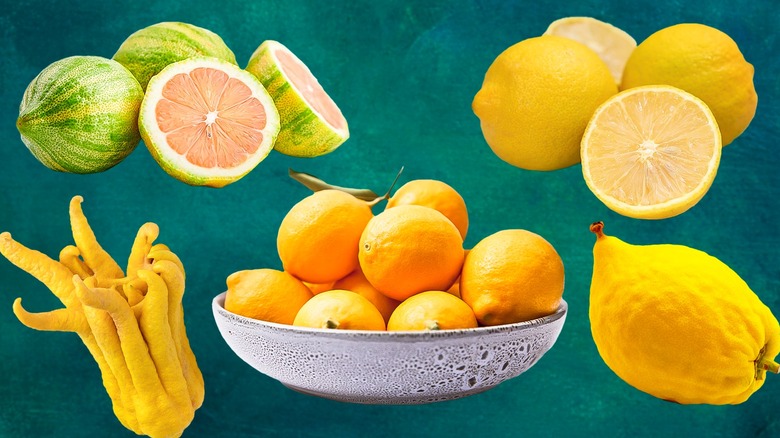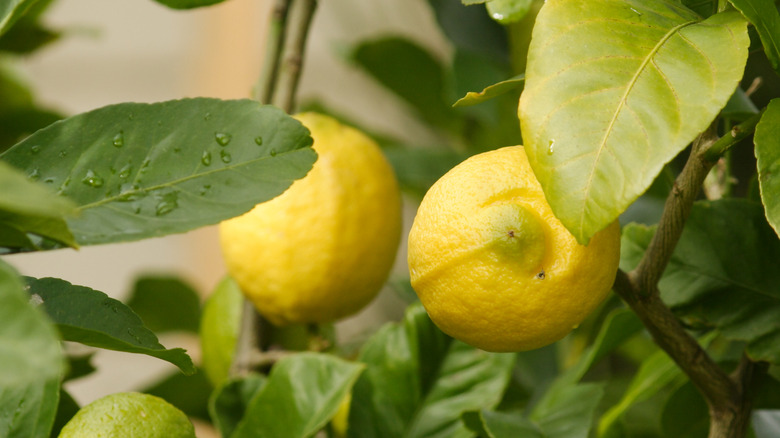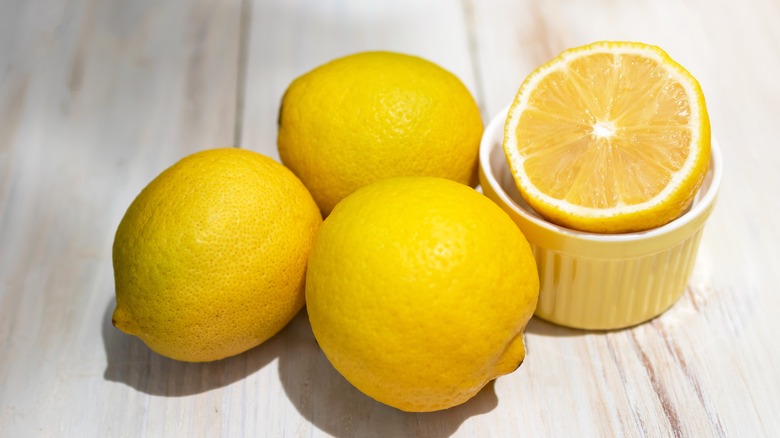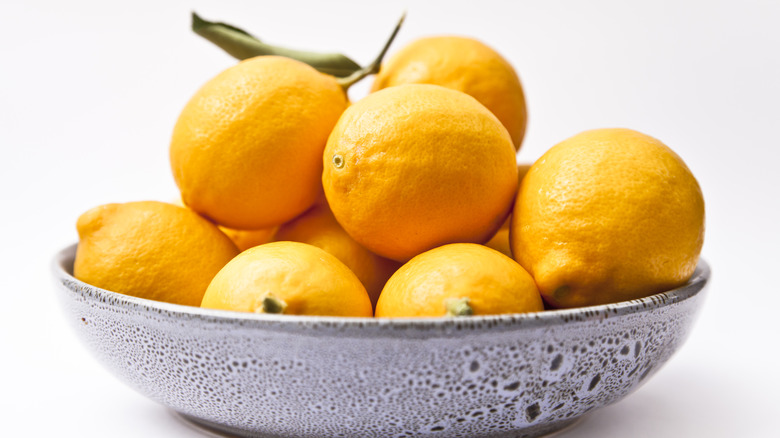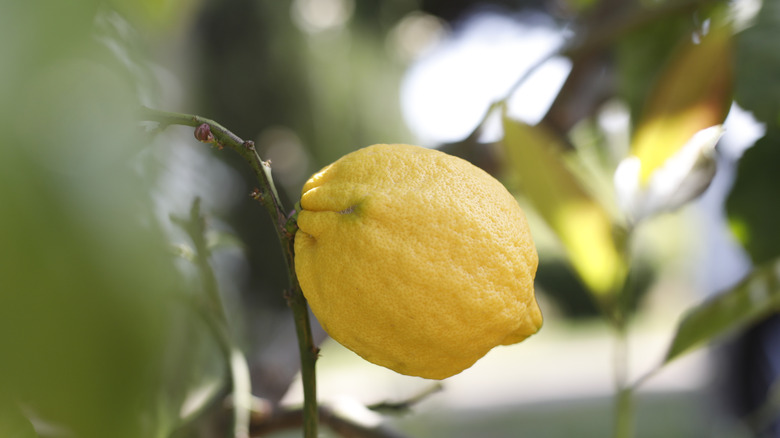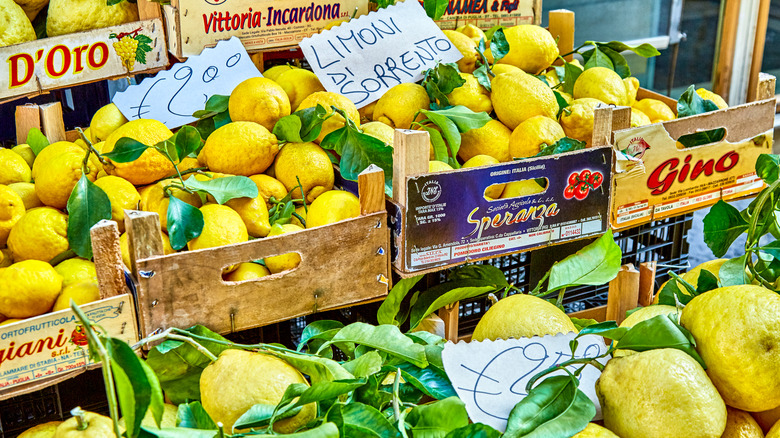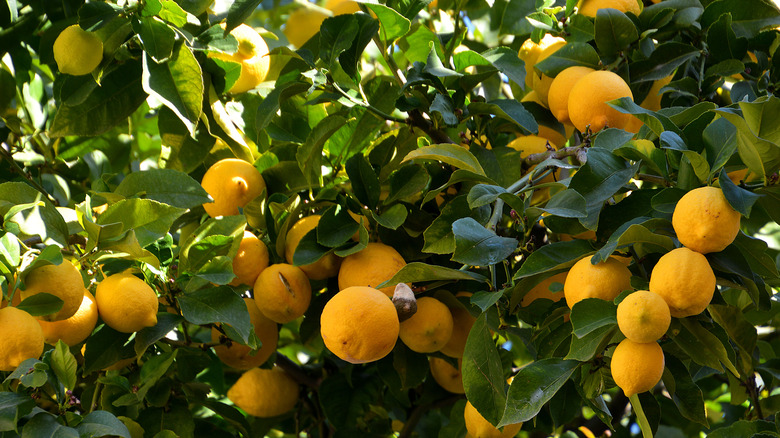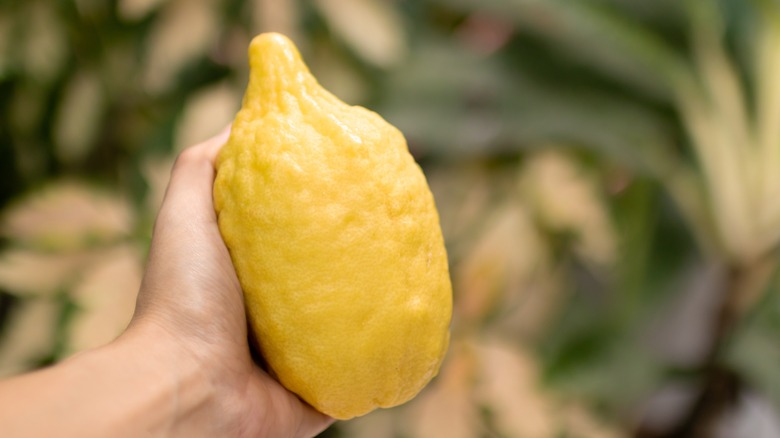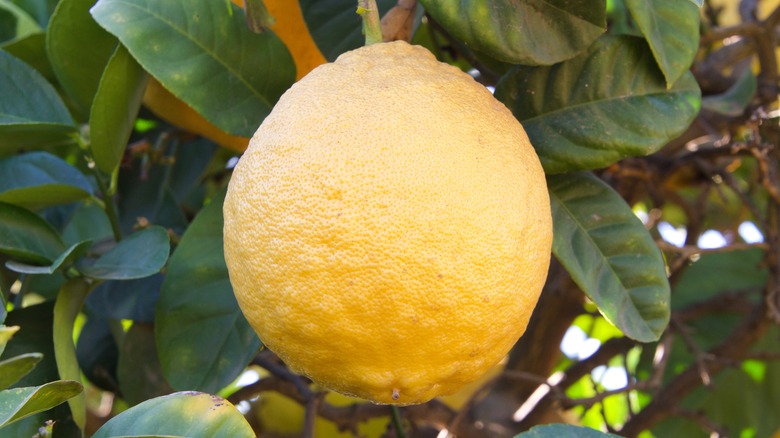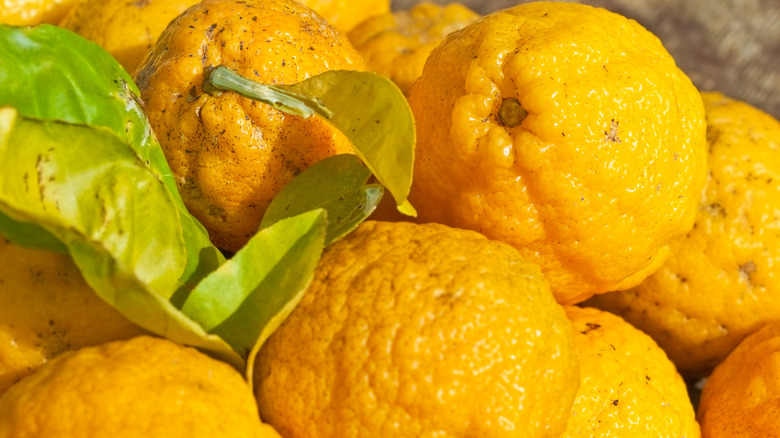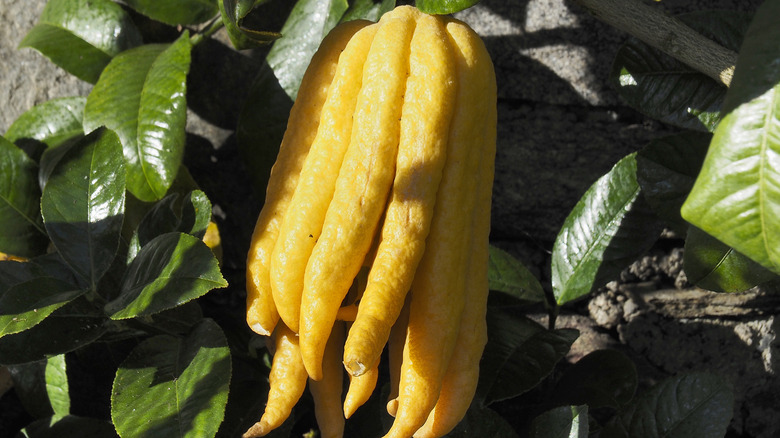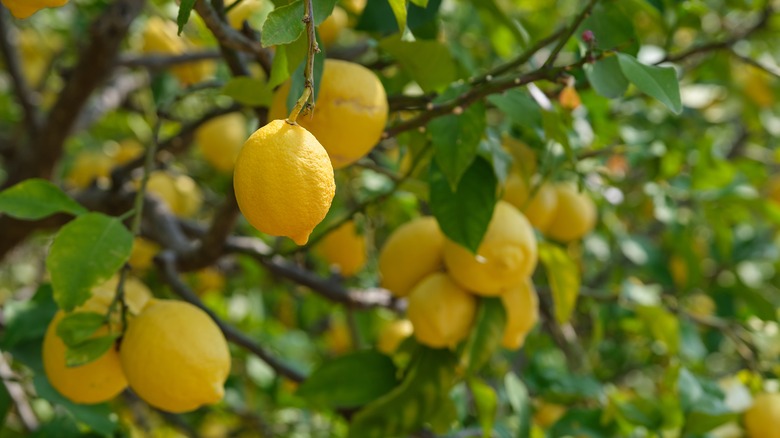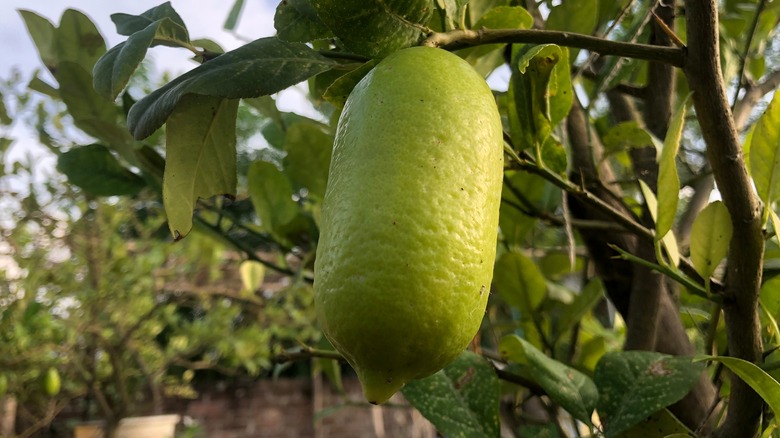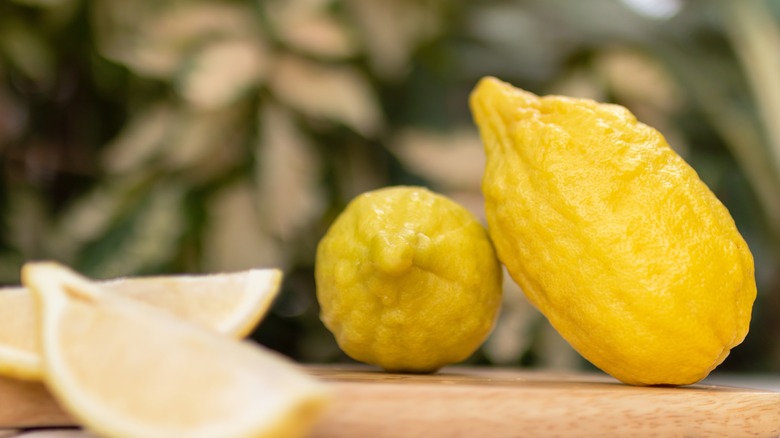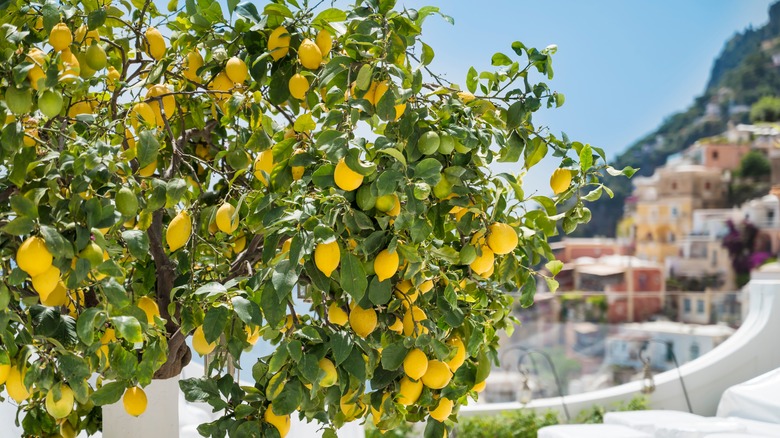14 Types Of Lemons And What Makes Them Unique
We may receive a commission on purchases made from links.
From festivals to the Crayola hall of fame, lemon makes an appearance in plenty of places where we can celebrate this vibrant, flavor-enhancing fruit. You can use it to make refreshing summer drinks like lemonade, mix the zest into cakes and pies for a burst of bright flavor, or even add lemon on top of chicken and fish in savory dishes. This fruit is a versatile kitchen rockstar and there are an almost endless variety of lemons out there, from standard yellow fruits with the characteristic tart flavor to pink-fleshed lemons and lemons with unusual shapes.
Each variety has its own unique taste, smell, shape, and even color, which can be fun both to grow and eat. Some can be harder to find than others, depending on where you live, but if you go on the hunt, you can find unusual varieties to mix it up. You can even try growing your own lemon tree (or bush, in some cases) to get an endless supply of citrus right at home.
Eureka lemons
These are your standard grocery store lemons, which are juicy, tart, and bright yellow. For most of us with just a general familiarity with lemons, these are the ones that we picture in our heads when we think of the fruit. You don't always see them labeled with the Eureka name, so if you see a display of just lemons, there's a good chance that they fall into this category. They are larger lemons when ripe and tend to be heavy when you hold them in your hand, thanks to the abundance of juice inside. Eureka lemons are also round, which is the main characteristic that distinguishes them from the Lisbon lemon, which is also a popular grocery-store option.
The exception to the standard Eureka lemon is the Variegated Eureka, which has a striped rind and pink interior. This variety looks much different but has a similar taste.
Eureka lemons don't have a lot of seeds compared to some varieties and you can grow them at home, but should plant them in a container that you can move inside if you live in a colder region. Like other lemon varieties, they like a warmer climate with plenty of sun and water. Eureka lemons grow on trees that can grow up to 20 feet tall. Because they are self-pollinating, you only need one tree to get delicious fruit, but it can take a couple of years for a young tree to mature enough to actually bear lemons.
Lisbon lemon
Another versatile lemon is the Lisbon lemon, which was first grown in Lisbon, Portugal. Today, it is a popular lemon that does well in citrus-growing areas and is a nice addition when you want the characteristic tart, tangy flavor of lemon in your dishes. While the taste of the Lisbon lemon is similar to the Eureka, the two varieties have different shapes. The Lisbon lemon is oval and has a thick, glossy yellow skin on the outside. It is very versatile and you can use the pulp, juice, and zest from the skin in everything from cooking to cleaning. Lisbon lemons have few seeds, which makes this a particularly great lemon for juicing.
They grow on trees but come in a semi-dwarf variety, which is smaller and easier to grow in a container. If you try to grow lemon trees in colder regions, you'll need to move them indoors during the winter months, so having a portable tree is ideal.
Meyer lemons
You may recognize the name of Meyer lemons, since this is the variety most often called for by name in certain recipes like these blueberry muffins or Ina Garten's hack to upgrade a margarita. These sweet lemons are a cross between a traditional lemon variety, typically Eureka or Lisbon, and a mandarin orange. The result is a milder lemon that adds a more subtle flavor to cooking that is almost flowery compared to the traditional tart taste of a standard lemon. It still brings a lot of brightness and acid, but tastes sweeter than other varieties. You can use Meyer lemons raw in some recipes or add the juice or zest to your baking when you want the flavor to be less intense.
Meyer lemons are also small compared to Eureka lemons, although they have a similar round shape. Just like the taste is less bold, the yellow color of the skin tends to be a bit more subdued. Overall, this lemon can be described as delicate in everything from taste to color. Honey made with the pollen of Meyer lemons is also delicate and delicious, just like the fruit itself, with citrus notes.
Bearss lemons
These lemons are a bit easier to pick, since Bearss lemon trees have fewer thorns than other varieties. The main benefit of these lemons is obvious to those growing them, either in containers or in the ground. They also grow fast, producing a lot of fruit that you can use just as you would any other lemon variety. Bearss lemons are round and have a lot of juice, although they are very tart and acidic compared to other types of lemons. So start with a light hand when you use these in your cooking until you get a feel for the how the flavor compares to what you are accustomed to tasting.
Bearss lemons are oval-shaped but fuller than Lisbon lemons, thanks to their high juice content. It can be hard to distinguish a Bearss lemon from other types of lemons at the market, so talk to the person selling them to be sure. They're a bit easier to notice when you see them on the tree because the branches are less prickly. Of course, you can always grow them yourself if you love to have lemons on hand and want to know exactly what variety you are working with as you cook.
Santa Teresa lemons
Can't get enough of sweet and tart limoncello? The traditional Italian liquor with a signature lemon flavor uses Santa Teresa lemons to get its iconic taste, thanks to their origin in Italy. They may be harder to find outside of their native region but you can find growers around the world that sell Santa Teresa lemons as well as lemon trees. You might also see them listed as femminello Santa Teresa lemons or Sorrento lemons, after the Sorrento region. Sorrento is located between Naples and the Amalfi Coast and is one of the top regions in Italy for lemon production.
The zest of Santa Teresa lemons is particularly strong compared to other types of lemons thanks to plenty of oils in the peel, which is what makes them perfect for fermentation and flavoring liquors. They have to ripen on the tree and have a short growing season, so if you're set on getting some fresh from Italy, start planning a trip for the late winter. You can also find them in citrus-growing regions like California, although they can be hard to track down since they are considered a specialty lemon.
Menton lemons
Imagine picking a fresh, tart lemon on the coast of the French Riviera and you're able to picture what it's like getting a Menton lemon from it's native France. Named after the Menton region where they grow, these lemons are a bit milder with a slightly sweeter taste than you might expect. They are also very fragrant, which is a key aspect to look for when picking out Menton lemons. These lemons grow on trees alongside olives and avocados and you can even visit lemon farms in the region to learn more about them, as well as enjoy tastings. Some farms and families have been in the lemon growing business for generations, relying on the area's beautiful weather to create the best growing conditions for citrus.
The lemon goes from pale yellow to bright yellow as it matures on the tree. These lemons are not grown outside of France and are designated by the Indication Géographique Protégée, or IGP, label. Menton IGP lemons are grown specifically in the Menton region and have to meet standards for quality as well as growing conditions.
Citron lemons
Citrons are actually cousins of lemons, but a distinct type of citrus. Compared to lemons, citron have been around much longer and played a role in the development of lemons, a new type of fruit when it burst on the scene. Citron are still around in their own right and make a fun substitute for lemons in certain types of cooking. This type of citrus fruit has a lot of lumps and little usable pulp, unlike a lemon. But the zest adds a lot of flavor to your dish.
You can also use the pith, the white part between the outer rind and the pulp inside, to create candies and in baking. It is not as bitter as the same section in other types of citrus. The amount of pith, pulp, and rind depends on the exact variety of citron, with some having similar amounts to lemons and others having almost no pulp at all.
Ponderosa lemons
Ponderosa lemons are some of the largest varieties out there, often dubbed the "5 pound lemon" due to their large size and heavy weight. They are actually hybrids between lemons and citron. When cooking, you can use the pulp, juice, or rind but it's the plentiful juice that really stands out in these lemons compared to other options. They have a similar taste and texture to Eureka or Lisbon lemons and can be used interchangeably with these fruits in cooking. The juice makes them a great choice for lemonade as well as dressings, where they add brightness and acidity.
Not only are the fruits of these trees large, the Ponderosa lemon tree also produces a whopping number of them through a long growing season. They start producing fruit in the late spring and can continue all the way through the winter months, depending on your region. You can prune them throughout the season to encourage new growth and make room for ripening fruit. Because they do tend to get large, make sure that you leave enough space for a full-grown tree, which can get up to 25 feet tall and 20 feet wide.
Bush lemons
The bush lemon grows as a shrub rather than a tree, so it needs a slightly different environment than other varieties in the garden. But they work in similar culinary applications to traditional lemon varieties, including in drinks, baking, and other dishes. This variety of lemons has a bumpier exterior but a deliciously tart pulp, juice, and rind. Because they are popular in Australia, bush lemons are the preferred variety to make Australian lemon butter. But, they grow in most places where other types of lemons thrive as well. In addition to making compound butter, you can use them to make infused olive oil or to brighten dishes like chicken noodle soup.
The bush lemon has denser foliage compared to some other types of lemon trees, so even though it doesn't need as much space overall, you may need to keep a close eye to snag ripe lemons when they are ready. When buying at the market, the nobby exterior is one of the best ways to distinguish a bush lemon from other varieties.
Buddha's hand lemons
If you want a one-of-a-kind citrus, look for the Buddha's Hand variety. They are actually citrons, a close relative of the lemon, but often sold alongside lemons and even called by that name. These are the most unusual looking citrus and easiest to tell apart from other options thank to the long tendrils of fruit covered by a rough exterior. They have a small circular base with numerous sections extended, almost like fingers attached to a palm, which is what gives them their unique name.
Because the overall shape is long and skinny, with tendrils rather than one compact fruit, these lemons don't work well if you want juice or pulp. They are one of the few juiceless lemons and most are completely pith inside with little or even no pulp at all. The rind is great for zesting but even that can be difficult, since it doesn't have a round or oval shape. They are most useful for their fragrance and as an exotic-looking fruit that has a lot of symbolism in some belief systems or religious practices.
Mediterranean sweet lemons
The Mediterranean sweet lemon is often grown in Italy, where it is used for to add a sweeter lemon taste to food as well as for its pleasant scent. Sorrento lemons are one example of a sweet lemon, but the name can refer to lemons with the signature taste and smell from around the entire Mediterranean. The interior of this lemon ranges from yellow to greenish and it has a sweet taste and scent. They have a bit of sourness but nothing compared to most other types of lemons. Even when you scratch the thin exterior, the scent created will be distinctly sweet and even floral. You can use these lemons in cooking if you want a hint of tartness without the intensity of other lemons.
It is sometimes also called just a sweet lemon or even a sweet lime, due to its unusual coloring as well as the flavor. The outside is mostly yellow, although not as vibrant as some lemon varieties. It grows on trees that can get around 4 feet tall, making it a good option for those who want to try growing their own citrus without the vast spaces required for larger trees.
Assam lemons
Also known as a Kaji Nemu lemon, these green fruits are native to Assam, India. They are a blend of sweet and sour, often used to flavor dishes, added to enhance beverages, or even prepared as pickles. The most distinct feature from the outside is their shape, which is more oblong than round. The rind tends to pale yellow rather than vibrant or bright and you might even see them with a greenish tint, especially if they are picked before ripening all the way. These lemons are also recognizable by their distinct fragrance, both on the tree as well as when using them in cooking. The scent has hints of both lemon and lime, with less tartness than other varieties.
These lemons are named for the region where they grow in India, Assam. They are still primarily grown in India, although they are exported to other parts of the world. They are used in a variety of culinary applications but do especially well to enhance flavor with a small amount of fresh squeezed juice bringing brightness to a dish.
Etrog lemons
This type of citrus has religious and cultural significance for the Jewish community, as they are used to celebrate Sukkot. Etrog lemons have bumpy exterior skins and are noticeably point at one end. They aren't common in most markets, although you can find them from specialty growers. Many people choose to grow their own etrogs, since they are self-pollinating and do not require a lot of complex care. However, they can get up to 10 feet tall if planted in the ground, so make sure to pay attention to the space required if you want to try growing them yourself.
Etrogs may have a lumpy exterior but they come with a delicate, floral fragrance. But they aren't commonly used in cooking because they have very little pulp and juice inside. Etrogs are mostly rind and pith, which makes them lightweight compared to what you'd expect from citrus of their size. Instead, etrogs are used ceremonially to celebrate the Jewish holiday of Sukkot , where they represent the heart or even ideals and beliefs common to that faith.
Amalfi Coast lemons
These lemons are grown exclusively on the picturesque Amalfi Coast in Italy, which is how they got their name. The lemon has a notable tart taste and is still grown using traditional practices in this small region. Because the Amalfi Coast is so rugged, the lemons have to be carried in baskets by workers from the groves to market and beyond. Amalfi lemons are elongated and bright yellow with plenty of juice. While Amalfi Coast lemons have a slightly bumpy exterior, it isn't as prominent as some other varieties. They have a bright, bold flavor but aren't overly bitter or sour, making them a great choice for cooking and sought after by chefs all over the world .
Amalfi Coast lemons also have a strong scent, both on the tree and off, which carries throughout the entire area. They are cultivated in groves but also grow well in gardens, on the side of the road, and in small sections of yard. They are plentiful throughout the region, which gives it the picturesque landscape that visiting people love to see. You can also find these lemons used to fragrance everything from room diffusers to candles .
